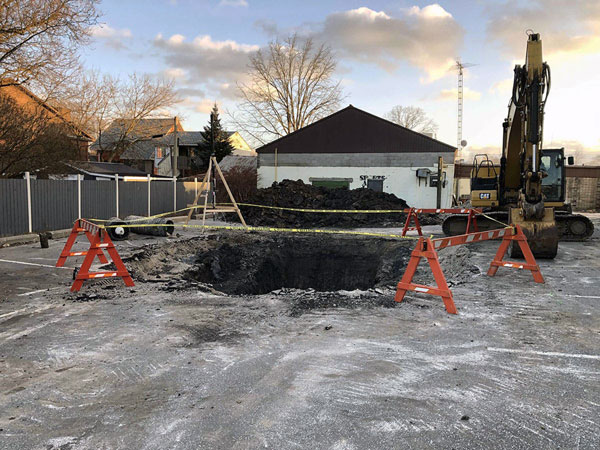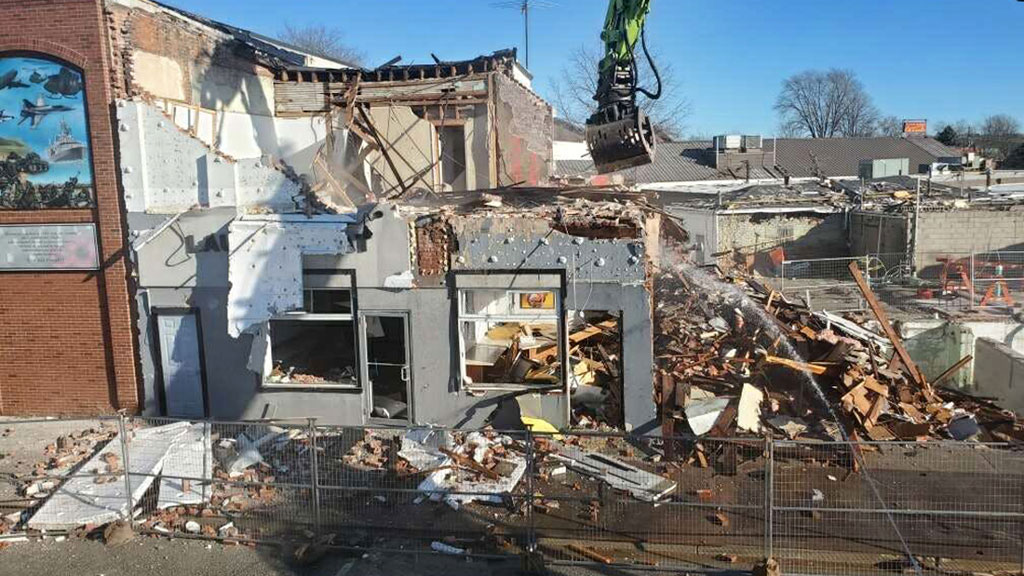On Aug. 26, 2021, an explosion in the town of Wheatley, Ont. occurred, significantly damaging buildings and leaving many injured. With the town evacuated, experts tried to figure out the cause. In the first of a three-part series, the Daily Commercial News takes a look at what has been done since the catastrophe and the answers the were found deep below the ground.
The downtown building explodes, casting brick, dust, glass and other debris into the air.
The security video records a handful of residents fleeing by foot and one in a black pickup truck. A large chunk of building material crashes into the street.
Firefighters already at the scene rush to aid a colleague who appears to have been caught in the blast.
The dust cloud thickens. At the corner of the street where the building exploded, traffic lights glow green then yellow.
Such was the scene a year ago, August 26, in Wheatley, Ont., a community of 3,000 people on the shores of Lake Erie in Chatham-Kent, when a gas leak from an unknown source in the downtown core reached explosive levels of concentration.
“When I ran out on the street, there was nothing but mayhem,” a resident recalled at a public meeting months after the blast.
Don Shropshire, the former chief administrative officer for Chatham-Kent, says 20 people were treated for injuries. Most were minor; “one of our staff that was seriously injured was off work for several months,” he says.
Dozens of residents and businesses had to be evacuated for months while specialists determined what went wrong and how to fix it.
One year later, remediation nears completion, and big-picture answers to what caused the explosion have been found: a gas leak from one, and possibly from more than one of three locations, all of which contain abandoned wells. One of these wells is gas and the two others are water wells.
More answers await in two yet-to-be-released reports – a final report from Golder Associates, the industry engineering consultant hired by the province, and a just-completed report of an investigation by The Office of the Fire Marshal.
As answers begin to flow, some of those involved wonder if the experience might prompt changes in how the provincial government and municipalities address the management of old oil and gas wells and how to respond if related emergencies arise.
One critical step in the aftermath, says Shropshire, was “saying to the province that we will do anything we can to help another community avoid going through what we’ve gone through…by looking at what we can do to make things better in the (future).”
The Explosion
Even though Ontario can lay claim to the continent’s first drilled oil well — in 1858 in what would become Lambton County – most Ontarians would never think to include petroleum production and the province in the same sentence.
Yet, from the 1870s to the early 1900s, the province was the seat of Canada’s oil and gas industry.

Production continues to this day, although at a much slower pace.
According to the Ontario Oil, Gas and Salt Resources Library, of the 27,000 wells listed in its registry, 1,200, on average, are active.
Many of the inactive wells were drilled 75 to 100 years ago; some are even older.
Many are “orphaned,” abandoned, for instance, after the company that drilled them went out of business.
Unknown is how securely capped these old wells might be. And those are just the registered wells. Another unknown is the volume of undocumented wells and their condition.
Anita Tamrazi, a spokesperson for the Ontario Ministry of Natural Resources and Forestry, says (by email) that the ministry has no idea of the volume of wells whose locations are lost and relies on “landowners and others to identify petroleum wells including those for which no records exist.”
The Ontario Petroleum Institute estimates 4,400 registered wells could “pose a risk to landowners and public health and safety” and the presence of “several thousand” unregistered wells in the province, Canada’s National Observer reports. The institute did not respond to the Daily Commercial News’ request for an interview.
Other incidents connected with former gas and oil wells in the province have occurred, including, since 2016, two other leaks in farm fields in Leamington.
Leaks from decommissioned, aging wells are recurring problems in the oil and gas industry, says Ryan Doull, a well-integrity specialist based in Alberta.
“As technology and administrative processes improve, it becomes less prevalent,” he says.
Doull says situations like those in Wheatley often start with a problem “downhole” in the well, such as poor cement integrity, that provides a path for gas to travel to the surface.
If the problem is internal, gas will migrate inside one of the casing strings into the atmosphere. If the problem is outside — between the well and geology — it can leak into the shallow ground around the well.
The urban setting is what makes the gas leaks that caused the Wheatley explosion unusual. Leaks in wells covered by surface structures are challenging to detect.
“It provides opportunity for a dangerous situation to happen, potentially,” Doull explains.
Yet it’s not the first time such an explosion occurred in this otherwise quiet lakeshore town.
Investigators’ research after the explosion uncovered records of several gas leaks during the 1930s, including an unexplained, early morning blast on Jan. 15, 1936.
According to a Toronto Star archival issue, that blast injured two women and levelled the two-storey brick Old Fellow’s Block that housed the town’s council chamber and post office.
Moreover, there had been warning signs in the months before the most recent blast.
On June 2, 2021, Whit Thiele, owner of the building that exploded, called 911 after he and a friend investigated an unusual odour in the basement, according to the Chatham Daily News.
It was hydrogen sulfide, a toxic gas that can occur in sewers, manure pits, well water and oil and gas wells.
Darrin Canniff, the municipality’s mayor, declared an emergency and evacuated several properties nearby.
“The municipality reached out to a number of different sources, including the province” and the private sector, says Shropshire, who continues to lead the local emergency response.
“The advice received was sometimes there is an emission, a gas burp, and it was the one and only time it occurs,” he says.
So, after two weeks of evacuation and observation, on June 26, the municipality lifted the declaration of emergency.
Then, on July 19, it happened again.
The municipality declared another emergency and evacuated 23 homes and 13 businesses. It also contacted the province again, which deployed a hazardous materials team based in Windsor to do testing.
Tamrazi says the ministry “had been working with the municipality to help determine the source of the gas leak and to provide 24-hour-a-day monitoring on the site to detect any further gas leaks. Through this monitoring, a third leak was detected on Aug. 26, that led to an evacuation of the downtown core.
“An explosion occurred approximately 90 minutes after the gas was detected.”
All told, the municipality evacuated more than 100 households and businesses, most for several months, while the complex remediation process began.
Part two of this series examines the aftermath and the steps taken to remediate the town.











Recent Comments